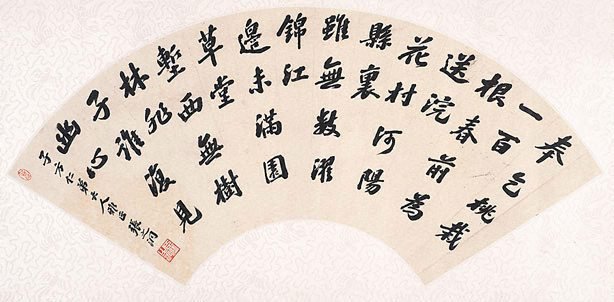-
Details
- Place where the work was made
-
China
- Period
- Qing dynasty 1644 - 1911 → China
- Media category
- Calligraphy
- Materials used
- ink on paper
- Dimensions
- 40.8 x 69.5 cm
- Signature & date
Signed l.l., in Chinese, inscribed in black ink "... Zhang Zhidong".
Signed l.l. corner, in Chinese, stamped in red ink “Chen Zhang Zhidong [artist's seal]".
Not dated.- Credit
- Gift of Dr. James Hayes 2003
- Location
- Not on display
- Accession number
- 301.2003
- Copyright
- Artist information
-
Zhang Zhidong
Works in the collection
- Share
-
-
About
‘I made a request for a hundred peach seedlings,
Before the spring, to be delivered to Huanhua village.
Once upon a time, spring petals flew throughout Heyang city
But here, at the side of Zhuojin River, spring buds have not yet filled the entire garden!
Beyond the moat of the thatched cottage, there are no trees,
Who could experience my exquisite feeling, except you?’
Inscription and signature: Written for the appraisal of Zifang. Zhang Zhidong.This calligraphy is composed of lines from two poems by the famous Tang dynasty poet Du Fu (712–70), written for a friend and executed on a fan. In the year 759, constrained by poverty and social upheaval, Du Fu moved from Gansu province to the outskirts of Chengdu in Sichuan, and built a thatched hut alongside Huanhuaxi (Flower Washing Brook). In order to make the surroundings more lush and green, he made requests to the county magistrate for peach seedlings (first poem), and to a friend for alder seedlings (second poem) (1). The name Heyang which he mentions alludes to the gifted poet of the Western Jin dynasty, Pan Yue (247–300), who during his time as the magistrate of Heyang (in Henan) turned the county into a peach garden! In traditional China, sustaining fertile grounds was considered an admirable deed for a local official, and the expression ‘planting trees’ was a metaphor for professional training: these thoughts might have been on Zhang Zhidong’s mind when he wrote the poems on the fan for a friend – possibly a fellow official.
Zhang Zhidong (alias Xiaoda, style name Xiangtao), younger brother of Zhang Zhiwan, was a native of Napi in Hebei province. He gained his ‘jinshi’ degree in 1863, attaining third place (‘tanhua’). He was appointed literary chancellor for Sichuan in 1873, became sub-reader of the Hanlin in 1880, and secretary in the Grand Secretariat in 1881. In 1882, he was made governor of Shanxi province. In 1884, he became viceroy of Guangdong and Guangxi, then governor of Hubei, viceroy of Jiangsu and Zhejiang, minister for commerce and minister of the State Council. One of the foremost reformers of his time, Zhang Zhidong promoted modernisation in the economy, education, transportation and the military during the last years of the Qing dynasty. He took charge of the construction of the Hanyang steel plant, then the largest of its kind in Asia, and the Hubei Firearms Factory. He also founded a mint, tanneries, tile and silk factories, and paper, cotton and wool mills. He helped build a railway line from Hankou in Hubei that extended towards the vicinity of Beijing. Concerned with rejuvenating and modernising China, he searched for ways that would allow the country to survive in a modern world and would accommodate Western knowledge but preserve traditional ways (2).
In calligraphy, Zhang was a devout follower of the calligraphy style of Su Shi (1037–1101), the eminent scholar and one of the four great Northern Song calligraphers. Like Su he was an expert in xingshu (running script). The calligraphy was executed with momentum; the bold vertical line but relatively thinner horizontal stroke, and the slightly horizontal emphasis, are all characteristics of Zhang’s script.
1 Du Fu, ‘Requests to Xiao Baming’s mansion for peach seedlings (Xiao baming fu shichu mitao zai)’; ‘Requests to He Yong for alder seedlings (Ping he shiyi shao fuyi mimu zai)’.
2 See Ke, Shaoming, et al. 1977, ‘Qing shigao’ (History of the Qing dynasty), Zhonghua Press, Beijing, ‘Biography’ 224; Hummel, W. Arthur (ed). 1943 ‘Eminent Chinese of the Ch’ing period, United States Government Printing Office, Washington, pp 27-31.‘The Poetic Mandarin: Chinese Calligraphy from the James Hayes Collection’. pg.86.
© 2005 Art Gallery of New South Wales -
Places
Where the work was made
China
-
Exhibition history
Shown in 1 exhibition
The poetic mandarin: Chinese calligraphy from the James Hayes collection, Art Gallery of New South Wales, Sydney, 23 Sep 2005–27 Nov 2005
-
Bibliography
Referenced in 2 publications
-
Sue Green, South China Morning Post, 'Scrolled gold', pg. 8, Hong Kong, 30 Oct 2005, 8 (illus.).
-
LIU Yang, The poetic mandarin: Chinese calligraphy from the James Hayes collection, Sydney, 2005, 86 (illus.), 87. cat.no. 21
-
